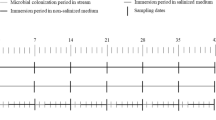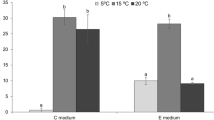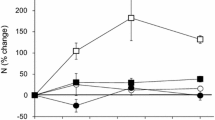Abstract
Freshwater salinization is a matter of major global concern due to its consequences on the aquatic biota and ecosystems functioning. Salt contamination negatively affects the leaf litter decomposition process, a key ecosystem-level process in forested streams that contributes to the recycling of nutrients and carbon storage. However, information on how additional factors may influence the magnitude of the response to salinization is scarce. In this microcosm study we assessed the importance of leaf (Castanea sativa; Quercus robur) traits, on aquatic hyphomycetes-mediated leaf litter decomposition and associated variables, in salt-contaminated (0, 1, 3 and 6 g/l NaCl) environments. The leaves were incubated individually, and in a mixture, for 28 days, under each tested salt concentration. Salinity depressed leaf mass loss, fungal biomass, respiration and sporulation rates, particularly at the highest salt concentration. Differences across leaf categories were observed in all parameters but fungal biomass, although the effects were not consistent across descriptors. All leaf categories responded with a similar intensity to salt contamination for all measured variables but sporulation rate. These results suggest that the deleterious influence of salt on litter decomposition occurs independently of the traits of the stream riparian subsidies.

Similar content being viewed by others
References
Abelho, M., 2009. ATP and ergosterol as indicators of fungal biomass during leaf decomposition in streams: a comparative study. International Review of Hydrobiology 94: 3–15.
Bärlocher, F., Y. K. Kebede, A. L. Gonçalves & C. Canhoto, 2013. Incubation temperature and substrate quality modulate sporulation by aquatic hyphomycetes. Microbial Ecology 66: 30–39.
Battin, T. J., K. Besemer, M. M. Bengtsson, A. M. Romani & A. I. Packmann, 2016. The ecology and biogeochemistry of stream biofilms. Nature Reviews Microbiology 14: 251.
Boulton, A. J., 1991. Eucalypt leaf decomposition in an intermittent stream in south-eastern Australia. Hydrobiologia 211: 123–136.
Boyero, L., R. G. Pearson, C. Hui, M. O. Gessner, J. Pérez, M. A. Alexandrou, M. A. S. Graça, B. J. Cardinale, R. J. Albariño, M. Arunachalam, et al., 2016. Biotic and abiotic variables influencing plant litter breakdown in streams: a global study. Proceedings of the Royal Society B 283: 20152664.
Cañedo-Argüelles, M., B. J. Kefford, C. Piscart, N. Prat, R. B. Schäfer & C. J. Schulz, 2013. Salinisation of rivers: an urgent ecological issue. Environmental Pollution 173: 157–167.
Cañedo-Argüelles, M., C. P. Hawkins, B. J. Kefford, R. B. Schäfer, B. J. Dyack, S. Brucet, D. Buchwalter, J. Dunlop, O. Frör, J. Lazorchak, et al., 2016. Saving freshwater from salts. Science 351: 914–916.
Canhoto, C. & M. A. S. Graça, 1999. Leaf barriers to fungal colonization and shredders (Tipula lateralis) consumption of decomposing Eucalyptus globulus. Microbial Ecology 37: 163–172.
Canhoto, C., S. Simões, A. L. Gonçalves, L. Guilhermino & F. Bärlocher, 2017. Stream salinization and fungal-mediated leaf decomposition: a microcosm study. Science of the Total Environment 599: 1638–1645.
Casas, J. J., A. Larrañaga, M. Menéndez, J. Pozo, A. Basaguren, A. Martínez, J. Pérez, J. M. González, S. Mollá, C. Casado, E. Descals, N. Roblas, J. A. López-González & J. L. Valenzuela, 2013. Leaf litter decomposition of native and introduced tree species of contrasting quality in headwater streams: how does the regional setting matter? Science of the Total Environment 458–460: 197–208.
Cheever, B. M., E. B. Kratzer & J. R. Webster, 2012. Immobilization and mineralization of N and P by heterotrophic microbes during leaf decomposition. Freshwater Science 31: 133–147.
Clay, N. A., S. P. Yanoviak & M. Kaspari, 2014. Short-term sodium inputs attract microbi-detritivores and their predators. Soil Biology and Biochemistry 75: 248–253.
Cornwell, W. K., J. H. C. Cornelissen, K. Amatangelo, E. Dorrepaal, V. T. Eviner, O. Godoy, S. E. Hobbie, B. Hoorens, H. Kurokawa, N. Pérez-Harguindeguy, et al., 2008. Plant species traits are the predominant control on litter decomposition rates within biomes worldwide. Ecology Letters 11: 1065–1071.
Dang, C. K., E. Chauvet & M. O. Gessner, 2005. Magnitude and variability of process rates in fungal diversity-litter decomposition relationships. Ecology Letters 8: 1129–1137.
Das, M., T. V. Royer & L. G. Leff, 2007. Diversity of fungi, bacteria, and actinomycetes on leaves decomposing in a stream. Applied and Environmental Microbiology 73: 756–767.
Duarte, S., F. Cássio, C. Pascoal & F. Bärlocher, 2017. Taxa-area relationship of aquatic fungi on deciduous leaves. PLoS ONE 12: e0181545.
Fernandes, I., C. Pascoal, H. Guimaraes, R. Pinto, I. Sousa & F. Cassio, 2012. Higher temperature reduces the effects of litter quality on decomposition by aquatic fungi. Freshwater Biology 57: 2306–2317.
Ferreira, V., E. Chauvet & C. Canhoto, 2014. Effects of experimental warming, litter species, and presence of macroinvertebrates on litter decomposition and associated decomposers in a temperate mountain stream. Canadian Journal of Fisheries and Aquatic Sciences 72: 206–216.
Gessner, M. O., 2003. Qualitative and quantitative analyses of aquatic hyphomycetes in streams. Fungal Diversity Research Series 10: 127–157.
Gessner, M. O. & E. Chauvet, 1993. Ergosterol-to-biomass conversion factors for aquatic hyphomycetes. Applied and Environmental Microbiology 59: 502–507.
Gessner, M. O. & E. Chauvet, 2002. A case for using litter breakdown to assess functional stream integrity. Ecological Applications 12: 498–510.
Gómez, R., A. D. Asencio, J. M. Picón, R. Del Campo, M. I. Arce, M. del Mar Sánchez-Montoya, M. L. Suárez & M. R. Vidal-Abarca, 2016. The effect of water salinity on wood breakdown in semiarid Mediterranean streams. Science of the Total Environment 541: 491–501.
Gomi, T., R. C. Sidle & J. S. Richardson, 2002. Understanding processes and downstream linkages of headwater systems: headwaters differ from downstream reaches by their close coupling to hillslope processes, more temporal and spatial variation, and their need for different means of protection from land. BioScience 52: 905–916.
Gonçalves, A. L., M. A. S. Graça & C. Canhoto, 2013. The effect of temperature on leaf decomposition and diversity of associated aquatic hyphomycetes depends on the substrate. Fungal Ecology 6: 546–553.
Gonçalves, A. L., M. A. S. Graça & C. Canhoto, 2015. Is diversity a buffer against environmental temperature fluctuations? A decomposition experiment with aquatic fungi. Fungal Ecology 17: 96–102.
Gonçalves, A. L., A. Carvalho, F. Bärlocher & C. Canhoto, 2019a. Are fungal strains from salinized streams adapted to salt-rich conditions? Philosophical Transactions of the Royal Society B 374: 20180018.
Gonçalves, A. L., S. Simões, F. Bärlocher & C. Canhoto, 2019b. Leaf litter microbial decomposition in salinized streams under intermittency. Science of The Total Environment 653: 1204–1212.
Graça, M. A. S., F. Bärlocher & M. Gessner, 2005. Methods to Study Litter Decomposition. Springer, Dordrecht.
Handa, I. T., R. Aerts, F. Berendse, M. P. Berg, A. Bruder, O. Butenschoen, E. Chauvet, M. O. Gessner, J. Jabiol, M. Makkonen, B. G. McKie, B. Malmqvist, E. T. H. M. Peeters, S. Scheu, B. Schmid, J. van Ruijven, V. C. A. Vos & S. Hättenschwiler, 2014. Consequences of biodiversity loss for litter decomposition across biomes. Nature 509: 218–221.
Jackrel, S. L., T. C. Morton & J. T. Wootton, 2016. Intraspecific leaf chemistry drives locally accelerated ecosystem function in aquatic and terrestrial communities. Ecology 97: 2125–2135.
Kaushal, S. S., G. E. Likens, M. L. Pace, R. M. Utz, S. Haq, J. Gorman & M. Grese, 2018. Freshwater salinization syndrome on a continental scale. Proceedings of the National Academy of Sciences 115: E574–E583.
Kominoski, J. S., C. M. Pringle, B. A. Ball, M. A. Bradford, D. C. Coleman, D. B. Hall & M. D. Hunter, 2007. Nonadditive effects of leaf litter species diversity on breakdown dynamics in a detritus-based stream. Ecology 88: 1167–1176.
Lecerf, A., G. Marie, J. S. Kominoski, C. J. LeRoy, C. Bernadet & C. M. Swan, 2011. Incubation time, functional litter diversity, and habitat characteristics predict litter-mixing effects on decomposition. Ecology 92: 160–169.
Li, L. J., D. H. Zeng, Z. Y. Yu, Z. P. Fan, D. Yang & Y. X. Liu, 2011. Impact of litter quality and soil nutrient availability on leaf decomposition rate in a semi-arid grassland of Northeast China. Journal of Arid Environments 75: 787–792.
López-Rojo, N., A. Martínez, J. Pérez, A. Basaguren, J. Pozo & L. Boyero, 2018. Leaf traits drive plant diversity effects on litter decomposition and fpom production in streams. PLoS ONE 13: e0198243.
Martínez, A., J. Barros, A. L. Gonçalves & C. Canhoto, 2020. Salinisation effects on leaf litter decomposition in fresh waters: does the ionic composition of salt matter? Freshwater Biology. https://doi.org/10.1111/fwb.13514.
Molinero, J., J. Pozo & E. González, 1996. Litter breakdown in streams of the Agüera catchment: influence of dissolved nutrients and land use. Freshwater Biology 36: 745–756.
Pérez, J., J. Galán, E. Descals & J. Pozo, 2014. Effects of fungal inocula and habitat conditions on alder and eucalyptus leaf litter decomposition in streams of northern Spain. Microbial Ecology 67: 245–255.
Pérez, J., A. Martínez, E. Descals & J. Pozo, 2018. Responses of aquatic hyphomycetes to temperature and nutrient availability: a cross-transplantation experiment. Microbial Ecology 76: 328–339.
R Development Core Team, 2016. R: A Language and Environment for Statistical Computing. R Foundation for Statistical Computing, Vienna.
Reis, F., E. Nascimento, H. Castro, C. Canhoto, A. L. Gonçalves, S. Simões, P. García-Palacios, R. Milla, J. P. Sousa & P. M. da Silva, 2018. Land management impacts on the feeding preferences of the woodlouse Porcellio dilatatus (Isopoda: Oniscidea) via changes in plant litter quality. Applied Soil Ecology 132: 45–52.
Sauer, F. G., M. Bundschuh, J. P. Zubrod, R. B. Schäfer, K. Thompson & B. J. Kefford, 2016. Effects of salinity on leaf breakdown: dryland salinity versus salinity from a coalmine. Aquatic Toxicology 177: 425–432.
Schäfer, R. B., M. Bundschuh, D. A. Rouch, E. Szöcs, P. C. von der Ohe, V. Pettigrove, R. Schulz, D. Nugegoda & B. J. Kefford, 2012. Effects of pesticide toxicity, salinity and other environmental variables on selected ecosystem functions in streams and the relevance for ecosystem services. Science of the Total Environment 415: 69–78.
Tank, J. L., E. J. Rosi-Marshall, N. A. Griffiths, S. A. Entrekin & M. L. Stephen, 2010. A review of allochthonous organic matter dynamics and metabolism in streams. Journal of the North American Benthological Society 29: 118–146.
Tyree, M., N. Clay, S. Polaskey & S. Entrekin, 2016. Salt in our streams: even small sodium additions can have negative effects on detritivores. Hydrobiologia 775: 109–122.
Vineis, P., Q. Chan & A. Khan, 2011. Climate change impacts on water salinity and health. Journal of Epidemiology and Global Health 1: 5–10.
Webster, J. R. & E. F. Benfield, 1986. Vascular plant breakdown in freshwater ecosystems. Annual Review of Ecology and Systematics 17: 567–594.
Wetterstedt, J, T. Persson & G. I. Ågren, 2010. Temperature sensitivity and substrate quality in soil organic matter decomposition: results of an incubation study with three substrates. Global Change Biology 16: 1806–1819.
Yeakley, J. A., D. Ervin, H. Chang, E. Granek, V. Dujon, V. Shandas & D. Brown, 2016. Ecosystem Services of Streams and Rivers. River Science: Research and Management for the 21st Century. Wiley, Chichester: 335–352.
Young, J. C., 1995. Microwave-assisted extraction of the fungal metabolite ergosterol and total fatty acids. Journal of Agricultural and Food Chemistry 43: 2904–2910.
Young, R. G., C. D. Matthaei & C. R. Townsend, 2008. Organic matter breakdown and ecosystem metabolism: functional indicators for assessing river ecosystem health. Journal of the North American Benthological Society 27: 605–625.
Zhang, M., X. Cheng, Q. Geng, Z. Shi, Y. Luo & X. Xu, 2019. Leaf litter traits predominantly control litter decomposition in streams worldwide. Global Ecology and Biogeography 28: 1469–1486.
Acknowledgements
This work was financed by FCT/MEC through national funds and the co-funding by the FEDER, within the PT2020 Partnership Agreement, and COMPETE 2020, within the Project UID/BIA/04004/2013; project ReNATURE—Valorization of the Natural Endogenous Resources of the Centro Region (Centro 2020, Centro-01-0145- FEDER-000007) also support AM (fellowship reference ReNATURE – BPD11_2). ESAJ thanks the Instituto Federal do Maranhão, Campus Barreirinhas, for the postgraduation licence (SUAP 23249.034907.2017-11). The authors thank the efforts of the two anonymous reviewers and Chris Swan for improving the manuscript and proofreading the English.
Author information
Authors and Affiliations
Corresponding author
Additional information
Handling editor: Marcelo S. Moretti
Publisher's Note
Springer Nature remains neutral with regard to jurisdictional claims in published maps and institutional affiliations.
Rights and permissions
About this article
Cite this article
Almeida Júnior, E.S., Martínez, A., Gonçalves, A.L. et al. Combined effects of freshwater salinization and leaf traits on litter decomposition. Hydrobiologia 847, 3427–3435 (2020). https://doi.org/10.1007/s10750-020-04348-1
Received:
Revised:
Accepted:
Published:
Issue Date:
DOI: https://doi.org/10.1007/s10750-020-04348-1




